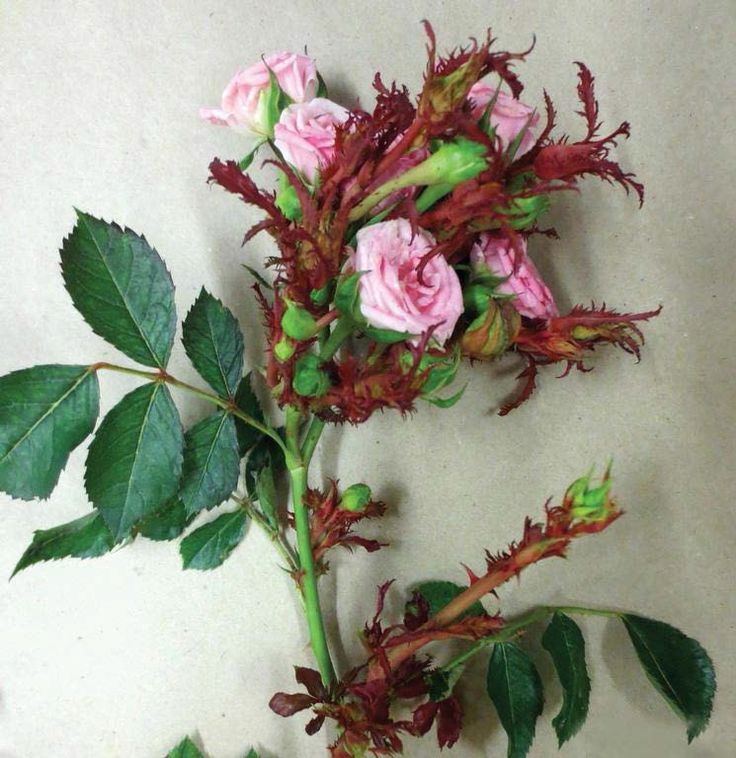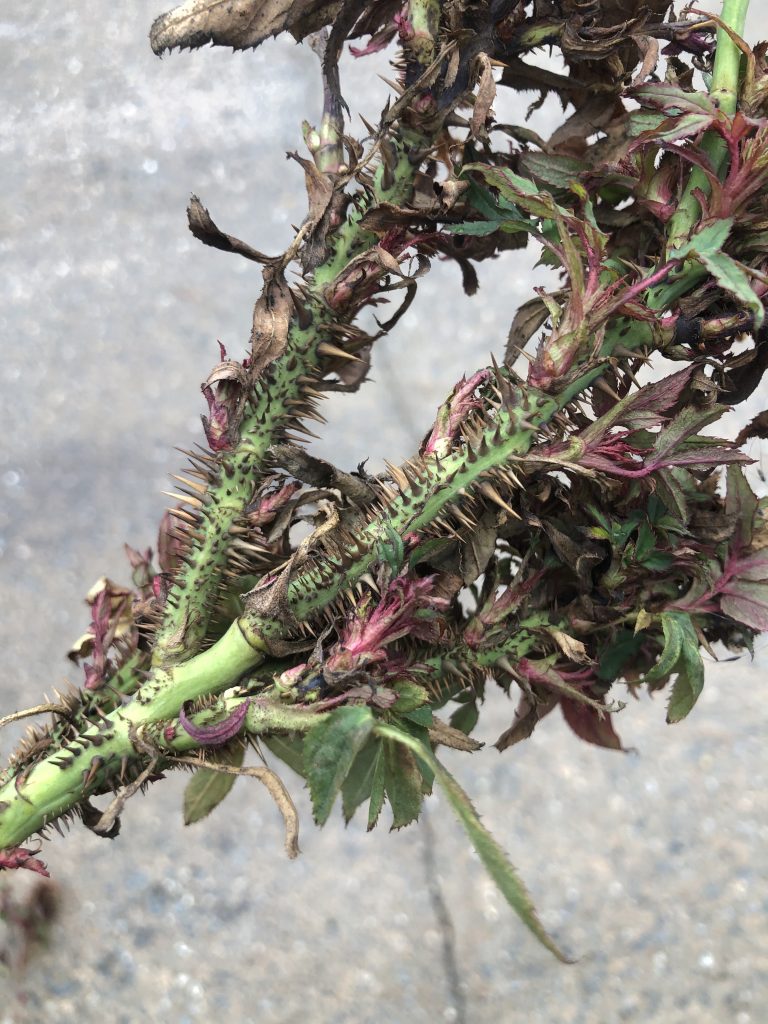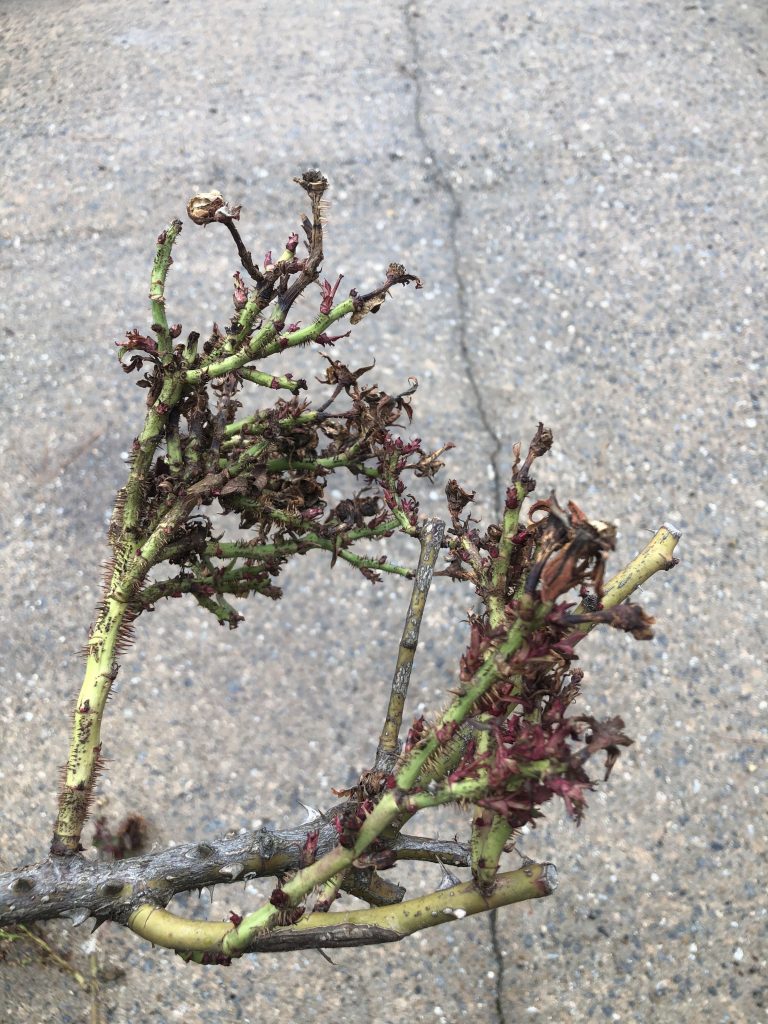Rose Rosette Virus Identification and Control

What is Rose Rosette Virus?
One of our beloved landscape plants, the rose, has been increasingly affected by this virus, which is spread by tiny wind transferred mites. Symptoms include thickened stem growth, excessive thorns, witches’ broom growth at end of stems, branch die-back, discolored and distorted leaves.

The above image shows the excessive thorn development on an affected rose. The symptoms of the virus can be fairly easily seen year round; this picture was taken in January of 2020. This particular rose showed no symptoms all spring, summer and even fall. After a late fall warm spell, the rose sprouted symptomatic new growth.
Prevention of Rose Rosette Virus
- Prune around Valentine’s Day each year. This will remove mites that might be overwintering in flower buds or seed heads. Dispose of pruned material; avoid composting in case mites or the virus is present. Tips on how to properly prune roses can be be found in this video.
- When doing yard clean-up, avoid using blowers. As we mentioned above, mites are often wind transferred and gusts of air can spread them through the landscape.
- Space roses well. Plant so that at mature size, leaves from one plant won’t touch another. This could reduce the occurrence of mites walking from one plant to another. Proper spacing also increases air flow which will help reduce the occurrence of other disease issues such as black spot.
- If you have been around infected roses, wash your hands, gloves, and clothes before working in the garden. All could have picked up mites. While the virus that causes rose rosette isn’t able to survive long outside of the plant, virus spreading mites may be present on your shovel or pruners. Clean tools with household disinfectant or a bleach solution before using them in the garden again. Overkill? Maybe, but mites are so tiny (1/200th of an inch) that they can easily hitch a ride on you or your tools.
- When designing your landscape, consider using alternative plants (see list below). There aren’t any other plants that offer the exact same features as a KnockOut or Drift rose but there are some wonderful re-blooming shrubs and others with outstanding foliage color.
The above image shows witches broom growth, which is the tight cluster of stems, leaves, buds and even flowers near the end of branches. This odd growth pattern is obvious even in winter months. If you think your plant may have rose rosette, take pictures and email them to us or bring a sample for identification (keep sample contained in plastic bag to help prevent spread).
Control
Unfortunately, there is no cure for this virus and affected plants will need to be removed and put in the garbage. Do not compost or burn the affected materials. For existing, unaffected roses, treat with dormant oil after cutting back in February, which could help control overwintering mites. Remove any fallen leaves or debris. Spraying with harsher chemicals could reduce the beneficial insects that feed on the mites.
If you have just one plant showing symptoms, remove that plant only and follow the prevention tips above to help control the spread. Although this disease can take years to kill a plant, during this long decline, many other roses may be infected by it (mites being wind transferred to unaffected roses). We recommend removing symptomatic plants as soon as they are identified as such. It will not help to prune out only symptomatic branches since the virus spreads throughout the entire plant, including the roots. Remove the entire plant, including as many roots as possible.
There are a few resistant rose varieties, including Top Gun, however, no variety has been proved 100% resistant. Research is ongoing. It would be best to avoid replanting with roses for at least one year if your landscape has been overcome with this virus. This is due to the fact that the virus may still be in remaining roots left in the ground after removal. Mites may have also already infected nearby roses, meaning that the virus could continue to spread onto newly planted roses.
There is conflicting information out there regarding whether treating healthy roses for the only known vector of this virus (eriophyid mite, Phyllcoptes fructiphilius) could slow down the spread of rose rosette. This particular mite may or may not be controlled by organic or nonorganic miticides (again, conflicting information from various extension organizations). If you would like to try to control this mite with nonorganic pesticides, the University of Arkansas Division of Agriculture Research and Extension Service recommends those with one of the following active ingredients in their fact sheet (FSA-7579): abamectin, bifenthrin, carbaryl, deltamethrin, imidacloprid, malathion or permethrin. In general, mites may also be managed using pyrethrum, which may be desirable for organic control.
Alternative Plants
While no plant can completely replace the April to November blooming period of KnockOut and Drift roses, here are several wonderful, hardy plants that offer either bright, long season blooms or colorful foliage all season long.
Weigela
Encore azalea
Dwarf or semi-dwarf butterfly bush
Dwarf loropetalum
Dwarf crapemyrtle
Kaleidoscope abelia (and other dwarf varieties with foliage color)
Compact nandina (several varieties)
Recovering from a substantial rose loss? Our team will be here to offer suggestions when you are ready to replant.
